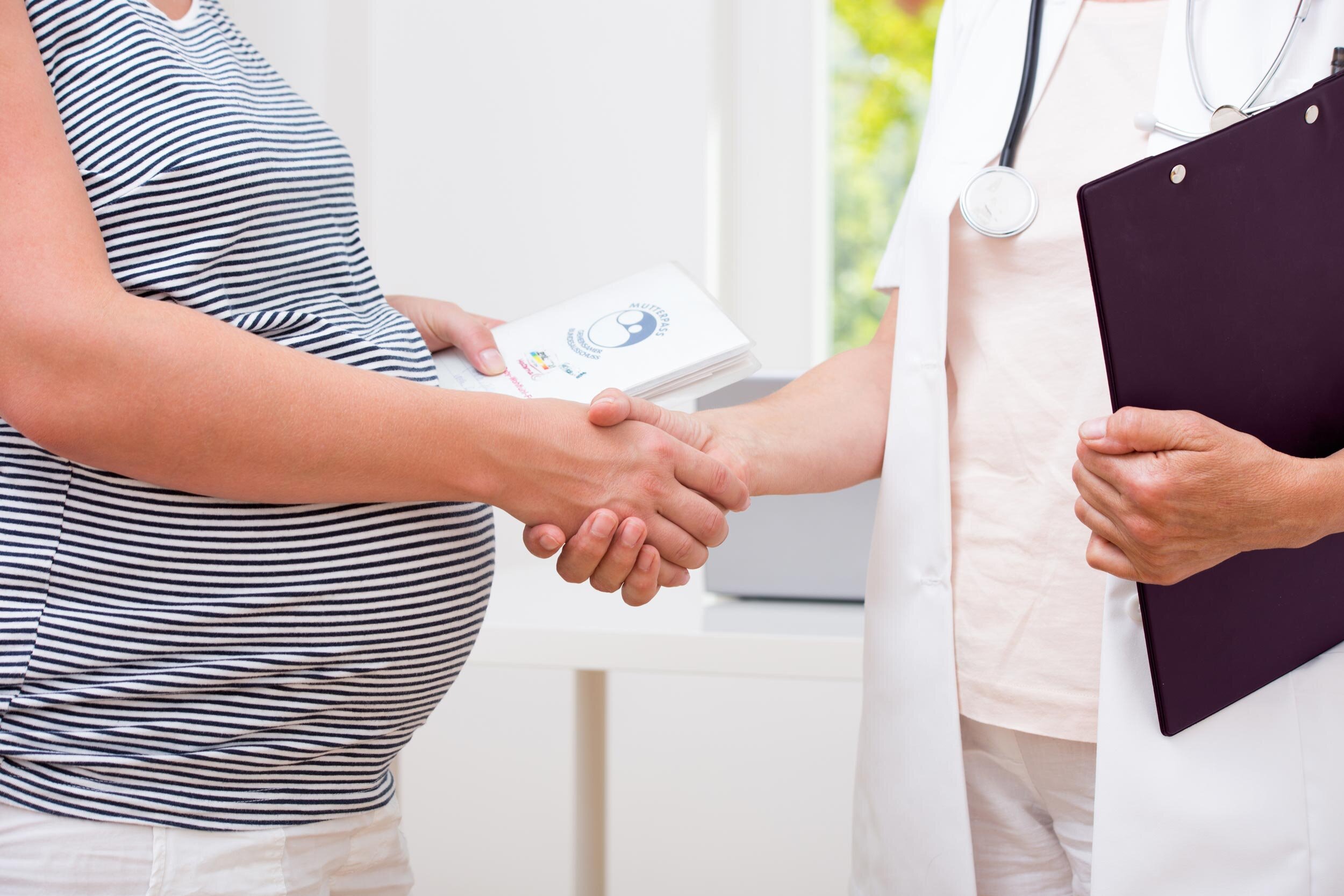Knowledge from midwifery practice
As a midwife, I would like to emphasise that the term ‘high-risk pregnancy’ is used to describe pregnancies in which certain factors or conditions could increase the risk of complications.
However, this does not mean that a high-risk pregnancy will necessarily lead to problems or be a negative experience. Instead, the aim of classifying a pregnancy as high risk is to ensure that both the future mother and the medical team are particularly vigilant and take extra precautions.
As a midwife, I want to reassure mums-to-be that a high-risk pregnancy does not necessarily mean that complications will occur. The label ‘high risk’ rather serves as an indicator that closer monitoring and specific precautions are needed to achieve the best possible outcomes for mother and baby.
Being pregnant always carries a certain risk. In some cases, however, the risk for mother and baby is higher than usual. That’s when a pregnancy is labelled ‘high risk’.
For mums-to-be, having a high-risk pregnancy can be quite distressing. However, it’s important to remember that it doesn’t necessarily mean that there will be an adverse outcome for either mother or baby.
If a pregnancy risk assessment indicates a higher risk than normal, this is merely a sign for healthcare professionals to keep a closer eye on the mother during pregnancy to identify signs of complications at an early stage.
What is a high-risk pregnancy? What age is high risk for pregnancy? What are the consequences for mother and baby? And what does a high-risk pregnancy mean for work?
Table of content
What is a high risk pregnancy?
Assessing high-risk pregnancies: pre-existing health conditions and medical history
Acute signs of a high-risk pregnancy: newly developed medical conditions
What does a high-risk pregnancy mean?
How to handle a high-risk pregnancy?
High-risk pregnancy and work: what are the rules?
Having a high-risk pregnancy doesn’t always mean that there will be problems
Summary: What is a high-risk pregnancy and how is it assessed?
What is a high risk pregnancy?
In general, the term high-risk pregnancy refers to a pregnancy that is associated with an increased risk. In this context, risk means that complications could occur during the course of the pregnancy. It is up to the treating healthcare professional to classify the pregnancy as high risk.
The National Institute for Health and Care Excellence (NICE) states that a “pregnancy is 'high risk' when the likelihood of an adverse outcome for the woman or the baby is greater than that of the 'normal population'.” In its guideline on intrapartum care for high-risk women, the NICE further states that “[the] level of risk may be determined before pregnancy or arise during pregnancy or during labour and can affect the woman or the baby.”
Assessing high-risk pregnancies: pre-existing health conditions and medical history
There are different factors that can lead to a pregnancy being classified as ‘high risk’. They include complications during previous pregnancies as well as developments and suspicious test results during the current pregnancy. Risk factors based on previous pregnancies or on pre-existing health conditions include:
- previous miscarriage or preterm birth
- serious long-term conditions in the mother
- older sibling who was born with a disease or malformation
- complications during a previous birth
- maternal age over 35 years or under 18 years
- hereditary diseases and genetic conditions in the family
- fertility treatment or previous uterine surgery
- mother being overweight
In addition to pre-existing health conditions (e.g. diabetes, heart disease or epilepsy) and complications during a previous pregnancy, there are other factors related to the current pregnancy that are taken into consideration during a pregnancy risk assessment.
Acute signs of a high-risk pregnancy: newly developed medical conditions
Pre-existing health conditions in the mother often increase the risk of complications during pregnancy. However, it’s also possible for the mother to develop new conditions during the current pregnancy that can lead to problems. Common newly developed conditions that lead to the pregnancy being classified as high risk are:
- severe iron deficiency during pregnancy and anaemia
- high blood pressure (hypertension)
- pre-eclampsia (high blood pressure in combination with signs of further organ damage)
- multiple pregnancy
- premature labour and bleeding during pregnancy
- blood group incompatibility between mother and child
- gestational diabetes
- placental insufficiency (inadequate supply of oxygen and nutrients to the foetus)

What does a high-risk pregnancy mean?
Basically, a high-risk pregnancy means that the future mother has to take particularly good care of herself and her baby in the weeks and months before the birth. This often involves following stricter rules regarding certain activities, work and maybe even nutrition. Pregnancies that are considered to be high risk are typically monitored more closely by the treating team of healthcare professionals.
Here is an overview of the different implications a high-risk pregnancy can have:
- Close monitoring: Depending on the assessed risk and the complications that could arise during pregnancy, additional antenatal appointments might be necessary. This means that the mother has to have her check-ups more frequently.
- Extra tests: If antenatal screening tests find something or if complications are detected during one of the regular antenatal care appointments, further tests might be needed. This can be an additional ultrasound scan, a CTG (cardiotocography), amniocentesis, chorionic villus sampling or additional blood tests during pregnancy.
- Dietary changes: A healthy pregnancy diet is recommended for all mums-to-be. However, complications such as the sudden onset of gestational diabetes can make further restrictions and dietary adjustments necessary.
- Safety during exercising and physical activity: A high-risk pregnancy can also mean that mums-to-be have to refrain from certain activities or make adjustments to their level of exercising. For example, mums-to-be have to be careful which activities they engage in if bleeding occurs during pregnancy or if there is an increased risk of miscarriage.
How to handle a high-risk pregnancy?
Whether mother and baby need to be monitored more closely over the course of the pregnancy depends on the results of the pregnancy risk assessment and on the complications that might arise during the current pregnancy.
Medical conditions such as gestational diabetes or unusual pregnancy ultrasound findings often require additional tests and close monitoring during the rest of the pregnancy. In other cases, however, there might be no acute need for action. For instance, if the pregnancy develops normally, the fact alone that the mother is older than 35 does not necessarily require instant medical intervention.
Another difference between a low-risk and a high-risk pregnancy is that a specialist appointment with an obstetrician will be offered if the pregnancy has been labelled as high risk. The aim of the appointment is for the mother to get a clearer view of what her individual pregnancy risks are.
Another topic that shouldn’t be neglected in high-risk pregnancies is the importance of mental health and stress reduction. Having her pregnancy labelled as ‘high risk’ can be distressing for a woman. In order to prevent unnecessary worries and stress, it’s important to get professional help and mental support.
High-risk pregnancy and work: what are the rules?
Employers have a general duty of care towards pregnant employees. What this means is that they have to carry out a health and safety assessment and remove any risks that might pose a danger to the mother while she is at work.
If this is not possible, the employer must offer suitable alternative work. In cases where this is not possible either, the employer can suspend the future mother from work until a suitable alternative is found. If there really is no other alternative, the suspension will be on full pay.
In addition to suspension on health and safety grounds, pregnancy-related absence from work might also be due to pregnancy-related illness. Pregnancy-related illness is any condition that is linked to the pregnancy. This includes special medical conditions associated with a high-risk pregnancy.
Having a high-risk pregnancy doesn’t always mean that there will be problems
Having their pregnancy classified as high risk can be very disconcerting for mums-to-be. However, it’s important to bear in mind that having a high-risk pregnancy doesn’t necessarily mean that there will be problems or complications.
There are many different factors that can lead to an increased risk during pregnancy and the risks associated with different pre-existing conditions and developments in the current pregnancy vary greatly. But just because a pregnancy is considered high risk, this doesn’t mean that the mother can’t have a normal pregnancy or that the pregnancy will be more challenging.
From a medical point of view, a high-risk pregnancy is simply a pregnancy that requires close monitoring and special attention to make sure that the pregnancy progresses in a way that is healthy for both mother and baby. That’s why having a high-risk pregnancy is not a bad thing per se.
Summary: What is a high-risk pregnancy and how is it assessed?
There are many questions surrounding high-risk pregnancies, including “When are you a high-risk pregnancy?” or “What age is high risk for pregnancy?”. Let’s sum up the most important aspects to remember.
There are basically two different criteria that can lead to a pregnancy being labelled as high risk. For one thing, the mother’s medical history can lead to a higher risk of complications during pregnancy or labour. For another, new medical conditions may develop during the current pregnancy that might lead to problems.
The pregnancy risk assessment must be carried out on an individual basis and by a qualified healthcare professional. Common risk factors for high-risk pregnancy include:
- maternal age over 35 or under 18
- complications, miscarriage or premature birth in a previous pregnancy
- twin pregnancy or multiple pregnancy
- pre-existing serious health conditions
- pregnancy-related illnesses such as gestational diabetes or pre-eclampsia
Resources
- 1 (nice.org.uk)
- Pregnant employees' rights - GOV.UK (www.gov.uk)
- Health and safety during pregnancy and on return to work - Maternity Action
- Suspensions from work for medical reasons - GOV.UK (www.gov.uk)
- Check health and safety risks - Managing pregnancy and maternity - Acas
- Sickness during pregnancy and maternity leave, and on return to work - Maternity Action
- Next-baby-info.pdf (bsuh.nhs.uk)
- High Risk Pregnancies - Do I have a choice? — Sarah Forster: Sarah Forster: The Indie Midwife, Independent Midwife, Middlesbrough, Durham, Newcastle, Leeds
- Mutterschafts-Richtlinie - Gemeinsamer Bundesausschuss (g-ba.de)
- https://www.frauenaerzte-im-netz.de/erkrankungen/schwangerschaftshochdruck-praeeklampsie/
- Risikoschwangerschaft: Was bedeutet das? | Apotheken Umschau (apotheken-umschau.de)
- 2023-09-28_G-BA_Mutterpass_web_WZ.pdf
- § 16 MuSchG - Einzelnorm (gesetze-im-internet.de)
- Welche Beschäftigungsverbote gibt es? | Familienportal des Bundes
- Vorsorgeuntersuchungen in der Schwangerschaft - familienplanung.de
- Sport – auch in der Schwangerschaft - familienplanung.de
- wd-9-051pdf-data.pdf (bundestag.de)

















